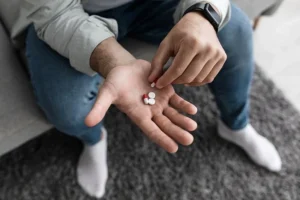Dealing with addiction can feel overwhelming like you’re stuck in a tough spot with no way out. But understanding what you’re facing and how to tackle it can really help. Whether it’s alcohol, opioids, or other substances, it’s important to know there are specific ways to get better.
In this blog, we’ll look at different types of substance use disorders. We’ll talk about how to spot them, how they can affect your life, and most importantly, how to treat them. Whether you’re looking for help for yourself or trying to support someone else, knowing your options can make a huge difference. So, let’s dive in and get started!
Contents
Common Types of Substance Abuse Disorders
Substance Use Disorders (SUDs) are complex conditions that manifest when regular substance use causes significant impairment, including health issues, disability, and failure to meet responsibilities at work, school, or home. So, here are some of the most common types of SUDs:
Alcohol Use Disorder (AUD)

- Alcohol Use Disorder is characterized by an inability to manage or stop alcohol use despite the negative consequences.
- Chronic consumption can lead to long-term brain changes, increasing the risk of mental health disorders and contributing to a cycle of dependence that can be hard to break.
- It ranges from mild to severe, based on the number of symptoms experienced.
Opioid Use Disorder (OUD)

- This disorder involves powerful substances including prescription pain relievers, heroin, and synthetic opioids such as fentanyl.
- Opioids bind to receptors in the brain, reducing the perception of pain and releasing large amounts of dopamine, which can strongly reinforce the act of taking the drug again and again.
- The disorder is marked by a physical and psychological urge to use opioid drugs, even when they cause harm.
Cannabis Use Disorder
- Despite some societal perceptions of cannabis as harmless, cannabis use disorder is characterized by addiction to marijuana. People with this disorder often use cannabis more often than they intend to and experience withdrawal symptoms when not using it.
Stimulant Use Disorder

- This category includes misuse of substances like cocaine, methamphetamine, and prescription stimulants. Regular use can lead to depletion of natural dopamine stores, leading to low moods and depression during withdrawal, and can increase tolerance, requiring higher doses for the same effect.
Each of these disorders impacts the brain differently but generally involves the reward centers of the brain, which are crucial in developing and maintaining addiction.
Drugs Commonly Abused
Substance abuse can involve a wide range of drugs, each with its own effects and potential for dependency. Here’s a list of some of the most commonly abused drugs:
- Alcohol
- Tobacco (Nicotine)
- Prescription Opioids (Oxycodone, hydrocodone, morphine, and fentanyl)
- Benzodiazepines (Valium (diazepam), Xanax (alprazolam), and Ativan (lorazepam)
- Amphetamines and Methamphetamines
- Cocaine
- Cannabis (Marijuana)
- Hallucinogens
- MDMA (Ecstasy/Molly)
- Inhalants (Aerosols, gases, and solvents that are sniffed or inhaled to achieve a quick high)
Understanding the diverse range of commonly abused drugs and their risks is crucial for prevention and treatment initiatives. If you or someone you know is struggling with substance use, seeking professional help can provide the necessary support for recovery.
What Causes These Disorders

Substance use disorders (SUDs) develop due to a complex interplay of factors that influence an individual’s likelihood of using substances in a way that becomes harmful. Here’s a look at the primary factors that contribute to the development of substance use disorders:
- Genetic Factors: Having a family history of addiction increases the risk, as certain genes can affect how a person reacts to drugs or alcohol.
- Family and Social Environment: Growing up in an environment where family members or peers use drugs or alcohol can normalize the behavior and increase the likelihood of substance use.
- Peer Pressure: Especially among teens and young adults, peer influence is a significant factor in starting and continuing to use substances.
- Availability of Drugs: Easy access to drugs or alcohol can increase the risk of substance abuse.
- Psychological Factors such as Mental Health Disorders (depression, anxiety, post-traumatic stress disorder) and high levels of stress
- Trauma: Experiencing traumatic events, especially during childhood such as abuse, neglect, or witnessing violence, can increase the risk of substance use disorders later in life.
- Cultural Norms: Cultural attitudes towards drug and alcohol use can influence behavior. In some cultures, heavy drinking or drug use might be more acceptable and even encouraged, leading to higher rates of substance use disorders.
- Economic Status: Poverty and lack of access to education, healthcare, and social services can contribute to the development of substance use disorders.
Treatment for Substance Use Disorders
 Treating Substance Use Disorders (SUDs) involves various approaches tailored to individual needs. Here are the key treatment modalities:
Treating Substance Use Disorders (SUDs) involves various approaches tailored to individual needs. Here are the key treatment modalities:
- Inpatient Treatment: Provides intensive care in a residential setting for severe SUDs or dual diagnoses, offering 24/7 support and a structured environment.
- Outpatient Treatment: Allows individuals to live at home while attending scheduled treatment sessions, suitable for those with mild to moderate SUDs and strong support systems.
- Individual Therapy: Focuses on one-on-one counseling sessions to address underlying causes of addiction, using techniques like Cognitive Behavioral Therapy (CBT) to change harmful behaviors and thought patterns.
- Group Therapy: Facilitates sessions with other individuals facing similar challenges, providing mutual support and shared learning experiences.
These treatment modalities provide the necessary support for effective recovery, addressing both the physical and psychological aspects of addiction to improve overall quality of life.
